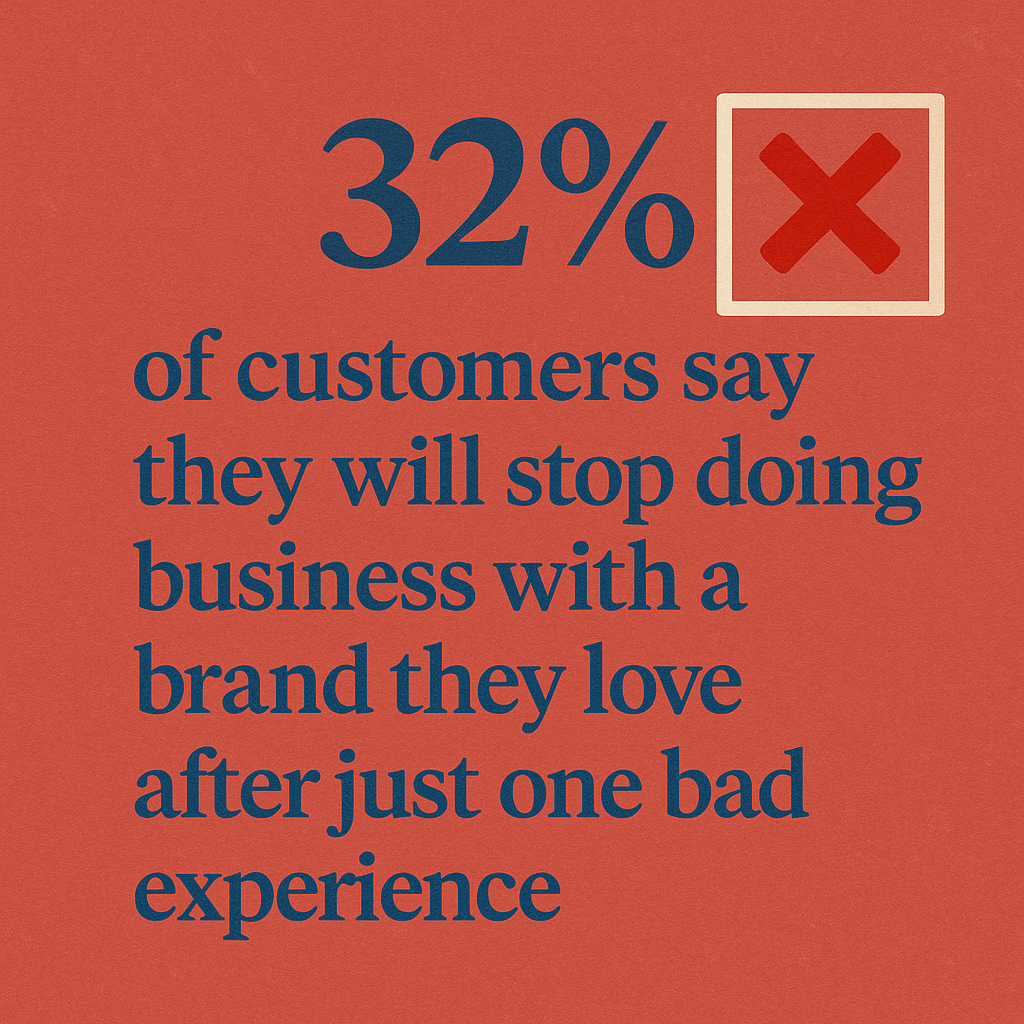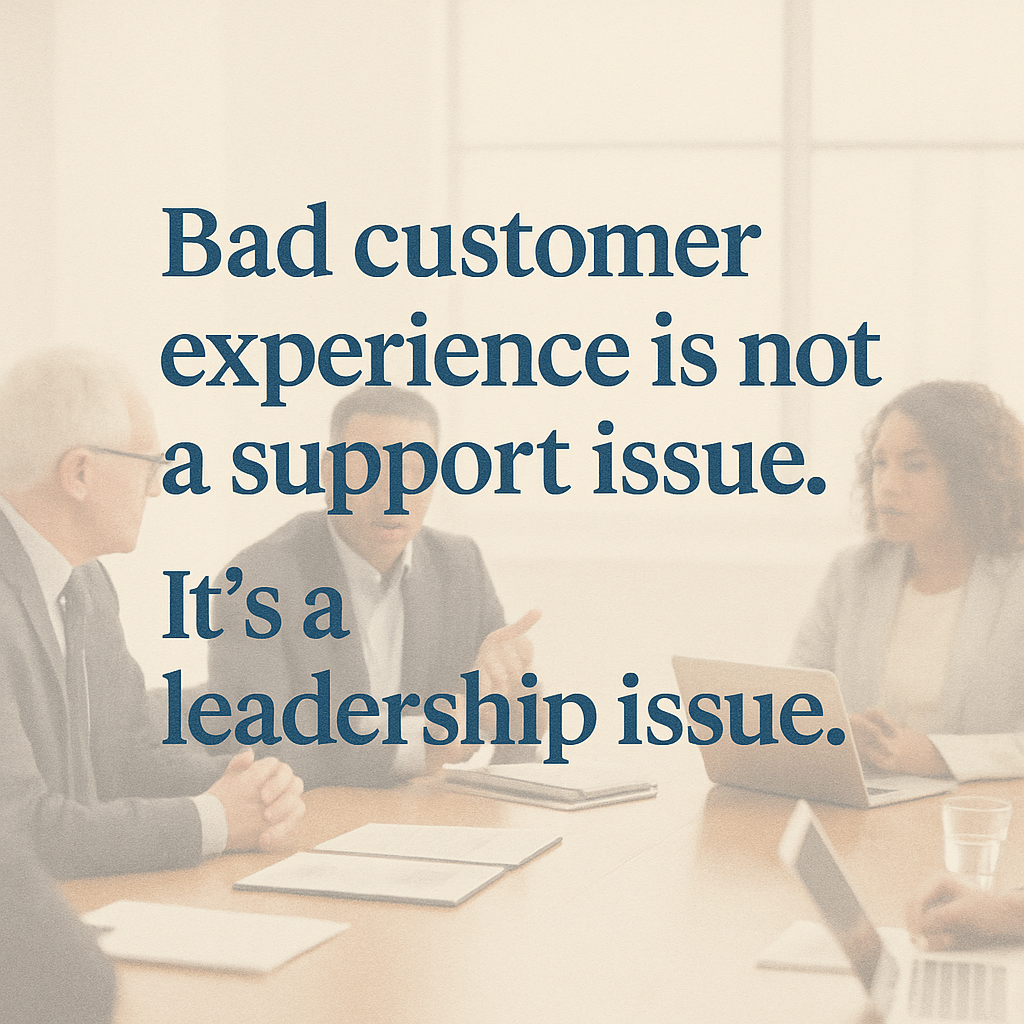By Peter Lauria – Partner, Customer and Buyer Journey
When we talk about business growth, Customer Experience (CX) is often framed as a value-add, a way to differentiate in a crowded market. But it goes much deeper than that, and the reality is starker: poor customer experiences are value-destroying forces. They erode brand equity, suppress growth, and cause ripple effects that impact not only individual businesses but entire industries.
During my corporate keynote speeches, I ask the audience if they ever had a poor customer experience with the businesses they interact with, and predictably, nearly every hand goes up. In today’s hyper-connected, review-driven economy, a single negative interaction can go viral, driving away thousands of potential customers, and worse, changing how people perceive your sector.
Short-Term Consequences: Revenue Leaks and Customer Churn

The most immediate impact of poor customer experience is lost revenue. According to PwC’s Future of Customer Experience report, 32% of customers say they will stop doing business with a brand they love after just one bad experience. That number climbs to 59% after multiple bad interactions. (PwC, 2018)
Let’s put that in context with a real-world example:
Case Study: United Airlines – The Guitar Heard Around the World
In 2009, musician Dave Carroll’s guitar was damaged by United Airlines baggage handlers. After repeated attempts to get compensation failed, he released a YouTube video titled “United Breaks Guitars.” The video went viral, racking up over 20 million views and causing a public relations disaster.
Impact? United’s stock price dropped 10% in the days following the video’s release, wiping out $180 million in market value, more than 1,000 times the cost of the guitar. But the deeper loss was trust. The incident became a cautionary tale that cemented a perception of airline indifference, fueling a broader narrative of poor CX in the aviation industry.
The lesson: a single bad experience, especially when mishandled, can drive not just churn, but reputational damage with measurable financial fallout.
Long-Term Consequences: Erosion of Brand Equity and Industry Sentiment
Over time, repeated CX failures erode trust, brand loyalty, and customer lifetime value (CLV). According to Forrester, brands with superior customer experience grow 5.1x faster than those with poor experiences. (Forrester CX Index, 2023) Conversely, companies with negative CX suffer brand decay that is hard to reverse.
The Domino Effect on Industries
Bad experiences don’t exist in a vacuum. When customers encounter friction repeatedly across different companies in the same sector, their frustration generalizes. Trust in the entire category drops. A 2021 Edelman Trust Barometer study found that 68% of consumers believe brands “need to do more to earn their trust.” The worst-hit industries? Telecoms, insurance, and airlines, sectors where negative CX is common and widely shared.
This affects newcomers and innovators too. When sentiment around an entire industry is low, new entrants must spend disproportionately on marketing and reassurance to earn consumer trust. On the flip side, it also presents an opportunity to break the trend by offering a differentiated experience and stealing market share.
Metrics that Matter: What to Track Beyond CSAT
To fully understand the business cost of poor CX, executives need to look beyond standard Customer Satisfaction Scores (CSAT) or Net Promoter Score (NPS). Those are snapshots. To measure the real impact, consider these KPIs:

Customer Churn Rate: According to Bain & Company, increasing retention rates by just 5% can boost profits by 25% to 95%. If CX is causing churn, you’re leaking revenue that’s expensive to replace.
Customer Lifetime Value (CLV): Poor experiences lower repeat purchases, upsell opportunities, and referrals, all components of CLV.
Negative Word of Mouth & Social Amplification: One negative review on Yelp can cost a business up to 30 customers (Harvard Business School, 2011).
Sentiment Analysis Across Channels: Use tools like Brandwatch or Sprinklr to monitor shifts in customer sentiment at an industry level, not just at a brand level.
Employee Turnover Rate: Poor CX environments are often mirrored by toxic internal cultures. If your frontline employees are disengaged, it’s often because they’re set up to fail, and that failure is passed directly to customers.
Example: Comcast’s CX Infamy and Its Long-Term Drag
Comcast has repeatedly ranked near the bottom of CX indices. A now-infamous 2014 call in which a customer tried to cancel their service – only to be stonewalled for over 18 minutes – became a case study in CX failure.
Despite being a monopoly in some markets, Comcast has spent billions trying to reverse its image, including the launch of its Xfinity brand and massive customer service overhauls. Yet, public trust remains low, and it continues to rank poorly in American Customer Satisfaction Index (ACSI) surveys.
This is a textbook example of brand debt, the accumulated damage of ignoring customer pain for too long. The cost of undoing this is not just financial; it’s strategic. Comcast has to outspend competitors just to stay in the race.
Why Executives Must Care: CX is a C-Suite Issue
Bad customer experience is not a support issue. It’s a leadership issue. Now go back and read that sentence again more slowly. It’s that important.

If you’re in the C-suite, here’s the bottom line:
- You can’t cut your way to customer loyalty. Efficiencies that save money at the expense of customer ease or empathy are self-defeating.
- CX failures create growth ceilings. No matter how aggressive your acquisition strategy, churn will cancel out your gains if the experience falters.
- Reputation now scales faster than ever. One tweet, one video, one bad review can catalyze long-term damage, or open doors for competitors. Social media travels fast.
The smartest companies embed CX into product design, operational KPIs, and even board-level reporting. Brands like Apple, Amazon, and USAA aren’t winning just on products, they’re winning on effortless, emotionally resonant customer journeys.
Turning the Ship: Fixing Bad CX Before It Sinks You
If your customer experience is slipping, the worst thing you can do is tinker at the edges. Real turnaround demands a cross-functional strategy:
- Map the End-to-End Journey: Identify friction points with real data, not assumptions. A carefully crafted Customer Journey Map can reveal gaps or shortcomings.
- Empower Frontline Employees: Give them autonomy, tools, and a mandate to resolve issues quickly.
- Close the Feedback Loop: Act visibly on customer feedback. Let customers see the changes.
- Link CX to Compensation: Tie bonuses and promotions to CX metrics at all levels, especially leadership.
Final Thoughts
A bad customer experience is not a one-off problem. It’s both a signal and a warning. It points to misaligned incentives, broken processes, or a lack of empathy at scale. In the short term, it hurts revenue. In the long term, it corrodes trust. Not just in your brand, but in your entire industry.
In the age of customer empowerment, where switching costs are low and public perception is everything, the cost of poor experience is too high to ignore.
As the old saying goes, and what I promote in my corporate keynote speeches, “People may forget what you said, but they will never forget how you made them feel.” In business, those feelings become numbers, and those numbers decide whether you thrive, survive, or disappear.
So next time I deliver a keynote and ask if anyone ever had a poor customer experience, what actions are you taking to make sure your business doesn’t comes to mind?
Want to avoid being the subject of the next viral video or a negative metric on an industry report? Let experts from The Weiwood Group help you map your customer journey to identify areas of improvement.

